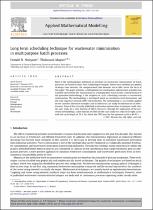 ResearchSpace
ResearchSpace
Long term scheduling technique for wastewater minimisation in multipurpose batch processes
JavaScript is disabled for your browser. Some features of this site may not work without it.
- ResearchSpace
- →
- Research Publications/Outputs
- →
- Journal Articles
- →
- View Item
| dc.contributor.author |
Nonyane, DR

|
|
| dc.contributor.author |
Thokozani, M

|
|
| dc.date.accessioned | 2012-11-02T07:19:35Z | |
| dc.date.available | 2012-11-02T07:19:35Z | |
| dc.date.issued | 2012-05 | |
| dc.identifier.citation | Nonyane, DR and Thokozani, M. 2012. Long term scheduling technique for wastewater minimisation in multipurpose batch processes. Applied Mathematical Modelling, vol. 36(5), pp 2142-2168 | en_US |
| dc.identifier.issn | 0307-904X | |
| dc.identifier.uri | http://www.sciencedirect.com/science/article/pii/S0307904X11005075 | |
| dc.identifier.uri | http://hdl.handle.net/10204/6275 | |
| dc.description | Copyright: 2012 Elsevier. This is the post-print version of the item. The definitive version is published in Applied Mathematical Modelling, vol. 36(5), pp 2142-2168 | en_US |
| dc.description.abstract | Most of the methodologies published in literature on wastewater minimisation for batch processes are based on short term scheduling techniques. When these methods are applied to longer time horizons, the computational time becomes intractable, hence the focus of this paper. This paper presents a methodology for simultaneous optimisation of production schedule and wastewater minimisation in a multipurpose batch facility. The key feature of the presented methodology is the adaption of cyclic scheduling concepts to wastewater minimisation. The methodology is developed based on continuous-time formulation and the state sequence network (SSN) representation. The methodology is successfully applied to two common literature examples and an industrial case study to demonstrate its effectiveness. None of the currently published wastewater minimisation techniques could solve the case study for a time horizon of 168 h. However, through the application of the presented methodology, a time horizon of 168 h for the case study was reduced to eight cycles with the cycle length of 23 h, for which the CPU time for the optimum cycle is 64.53 s. | en_US |
| dc.language.iso | en | en_US |
| dc.publisher | Elsevier | en_US |
| dc.relation.ispartofseries | Workflow;7717 | |
| dc.subject | Multipurpose batch processes | en_US |
| dc.subject | Wastewater minimisation | en_US |
| dc.subject | Production schedule optimisation | en_US |
| dc.title | Long term scheduling technique for wastewater minimisation in multipurpose batch processes | en_US |
| dc.type | Article | en_US |
| dc.identifier.apacitation | Nonyane, D., & Thokozani, M. (2012). Long term scheduling technique for wastewater minimisation in multipurpose batch processes. http://hdl.handle.net/10204/6275 | en_ZA |
| dc.identifier.chicagocitation | Nonyane, DR, and M Thokozani "Long term scheduling technique for wastewater minimisation in multipurpose batch processes." (2012) http://hdl.handle.net/10204/6275 | en_ZA |
| dc.identifier.vancouvercitation | Nonyane D, Thokozani M. Long term scheduling technique for wastewater minimisation in multipurpose batch processes. 2012; http://hdl.handle.net/10204/6275. | en_ZA |
| dc.identifier.ris | TY - Article AU - Nonyane, DR AU - Thokozani, M AB - Most of the methodologies published in literature on wastewater minimisation for batch processes are based on short term scheduling techniques. When these methods are applied to longer time horizons, the computational time becomes intractable, hence the focus of this paper. This paper presents a methodology for simultaneous optimisation of production schedule and wastewater minimisation in a multipurpose batch facility. The key feature of the presented methodology is the adaption of cyclic scheduling concepts to wastewater minimisation. The methodology is developed based on continuous-time formulation and the state sequence network (SSN) representation. The methodology is successfully applied to two common literature examples and an industrial case study to demonstrate its effectiveness. None of the currently published wastewater minimisation techniques could solve the case study for a time horizon of 168 h. However, through the application of the presented methodology, a time horizon of 168 h for the case study was reduced to eight cycles with the cycle length of 23 h, for which the CPU time for the optimum cycle is 64.53 s. DA - 2012-05 DB - ResearchSpace DP - CSIR KW - Multipurpose batch processes KW - Wastewater minimisation KW - Production schedule optimisation LK - https://researchspace.csir.co.za PY - 2012 SM - 0307-904X T1 - Long term scheduling technique for wastewater minimisation in multipurpose batch processes TI - Long term scheduling technique for wastewater minimisation in multipurpose batch processes UR - http://hdl.handle.net/10204/6275 ER - | en_ZA |





